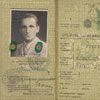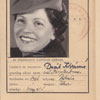Béla Stollár
Hungary

Béla Stollár was born in 1917 into a military family. He was a sports reporter, wrote for Nemzeti Sport (National Sport), which was Hungary's main sports newspaper. He specialized in coverage of swimming and boxing events. In the 1930s Béla Stollár had several Jewish friends amongst who were the Deáks. In 1943, Stollár was drafted. Being that he was a Hungarian champion in stenography, he was assigned to work in this capacity as a lieutenant at the Staff Headquarters in the Ministry of Defense. There he was able with ease to obtain various blank official forms, stamps, and signets. In 1944, he made use of these items to save Jews.
In the fall of 1944, after the Szálasi take-over, Stollár, for example, gave forged identity papers to Éva Deák, ennabling her to live and work as a governess in the provinces. He also provided papers for Éva’s mother. Immediately following the German occupation of Hungary in March 1944, the Germans arrested and interned István Deák, Éva’s father. He was released from the Kistarcsa internment camp on October 15, 1944. He went straight to Stollár’s apartment at no. 33/b Ráday Street in the 9th District of Budapest. Stollár hid him there for weeks. Still in October, after the Szálasi take-over, István Deák’s son, István Deák Jr., escaped from forced labor. Stollár hid him as well. In June 1944, right after taking his matriculation exam, István Jr. was drafted for forced labor service. He was taken to Transylvania where his unit of forced laborers was building a railroad. Béla Stollár stayed in constant touch with him via mail and informed him about his family’s welfare. Occasionally he was also able to send him food and money, something, which was absolutely forbidden. Péter Deák, a cousin to Éva and István, was also able to escape from forced labor with the help of false documents given to him by Stollár. Béla Stollár attempted to save Éva and István’s grandmother, Mrs. Hermann Deustch as well. She had been taken to a death march towards the Austrian-Hungarian border from a yellow–star house in Budapest on November 17, 1944. Stollár followed the group wearing his uniform intending to bring her back to Budapest using a court order, which he had forged. However, he was not able to find her.
In 1944, Béla Stollár organized an armed resistance group within Endre Bajcsy Zsilinszky’s resistance movement. They fought against the German invaders, and even more so against the Hungarian Arrow Cross forces. Stollár obtained the use of an apartment for his group in Budapest at no. 22 Klotild Street (this street was renamed after Béla Stollár following the war). He also obtained forged documents, forged military orders, as well as food and arms for the members of the group who were either escaped Jewish forced laborers or deserters of the Hungarian army.
On December 25, 1944, a lorry filled with armed Arrow Cross men arrived to Klotild Street in order to look for Stollár and his men. They came on the basis of a tip that they had received from an informant. The Arrow Cross men broke into the house. Béla Schóber, the building concierge, tried to alert the group using a warning bell. The Arrow Cross men murdered Schóber, his wife and another couple – relatives who were there by chance. After the executions, the Arrow Cross men attacked Stollár’s group. The majority of the group members escaped through the roof, but Stollár stayed behind with a few others in order to burn all the documents in the apartment. For a while they were able to hold the Arrow Cross men off with hand grenades, but eventually everyone who stayed behind was killed.
Éva Deák, her brother István and their parents survived the Holocaust. Éva later married Pál Veress, journalist and painter, with whom she lived a happy life for over fifty years. They had three daughters, five grandsons and two great-grandchildren. Éva has been the editor-in-chief at Corvina Press, the Hungarian foreign language publishing house that brought out art books and translations of Hungarian literature. Following her retirement, Éva has been translating scientific, artistic, and fictional literature from English, French, and German into Hungarian; she also wrote several books, mostly for children, such as "I am Discovering Budapest" and "I am Discovering Lake Balaton" which became very popular and have seen many editions. Eva passed away in 2010 at the age of 88.
István Deák, Seth Low Professor Emeritus at Columbia University, began his university studies in Budapest. Following his departure from Hungary in 1948, he studied history at the Sorbonne in Paris and worked as a journalist and librarian in both France and Germany. Since 1956, he has been residing in New York City where he studied modern European history at Columbia University. He obtained his PhD degree in 1964 and taught at Columbia University until his retirement in 1997. He was the Director of the University's Institute on East Central Europe between 1968 and 1979. Following his retirement, Istvan Deák taught at Columbia University as a special lecturer. In 1999, 2002, and 2005 he was visiting professor at Stanford University. Istvan Deák is married to Gloria, nee Alfano, a writer and an editor. They have one daughter and one grandson.
Péter Deák survived the Holocaust, later got married, had 2 children, 3 grandchildren, 1 great grandchild. He retired as the vice director of a state owned trading company. He passed away in 2010 at the age of 90.
On March 5, 2003, Yad Vashem recognized Béla Stollár as Righteous Among the Nations.
Yad Vashem would like to thank István Deák, Fruzsina Veress, Anna Veress, Péter Deák Jr. and the staff of the Embassy of Israel in Hungary for providing additional materials and background for this story.














